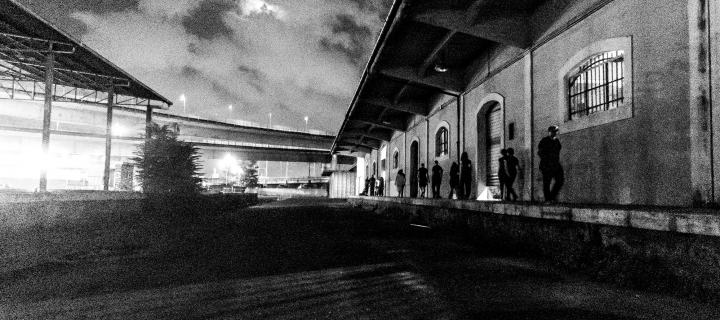In September 2015, in the city of Rome, the Chaos League organized The Legend of Percival (La leggenda di Parsifal); a pervasive larp which cannibalised reality for a few days by asking its players to play the role of outcasts in search of their own physical and mental place: A search conducted within and without the self. Set in modern times and inspired by the works of Terry Gilliam (The Fisher King, 1991), Jim Jarmusch (Ghost Dog, 1999) and Alan Moore (V for Vendetta, 1982), the event was designed to delve into the concepts of marginality and morality.
The characters played in The Legend of Percival all shared a painful personal history and were persuaded to be the moral heirs of the legendary knight Percival. Their attempt was to establish a new community – the reborn Camelot – on values such as mutuality, moderation and strict adherence to the inflexible moral code of medieval knights. Plunged into the throbbing heart of a chaotic Rome, they struggled against the annihilation of humanity.
Needless to say, the underlying objective of this larp was to stimulate an unbiased debate about modern society – overwhelmed by individualistic views and interested only in the accumulation of superfluous objects – through the fictional expedient of larp. The style of play was 360° degrees illusion, without interruption and without use of meta-techniques.
Collaborative Writing

First step in Camelot.
Before actually playing, participants created their characters under the guidance and supervision of the organisers. In outlining their personal traits, players were asked to give special attention to the construction of what was labelled the “pillar collapse”. This meant a traumatic event supposed to be the starting point of a death–rebirth process for each character. In layman’s terms, the “pillar collapse” could be represented by a bereavement in one’s family or by disturbing experiences able to make the characters question everything in which they firmly believed, able to shake their ideas and their way of life.
Simultaneously, players were asked to begin to follow a training course, which would put them in an exact mental and physical state to face the larp properly. Participants were assigned meditation and breathing exercises (partly borrowed from the Zen tradition), which were to be performed on a daily basis for two weeks before the beginning of the game. For example, some of the assignments were based on selective auditory drills of self-listening and surrounding environment listening, in order to trigger an improved mastery of one’s interior space. The final goal of such training was to prepare players to the rhythms and concepts they would face during the live event, to reduce the impact with a reality very different from their everyday life.
The third phase of the “diffused game” (a pre-game stage which took place entirely online) introduced characters to the inner workings of the game.
Players had a series of clues to follow (the so-called “signs”), which showed similarities to a recently discovered ancient prophecy concerning Percival. In these analogies they recognized (or thought they did) their own personal histories. This led them to believe they were the recipients of the prophecy and were therefore called to action.

Knights dormitory.
The Signs
One of the main narrative devices of the game was that of the “signs”. These were enigmatic epiphanies that characters could grasp and freely decipher by virtue of their own peculiarity and eccentricity. Asked to interpret marginalized and cast out people, players were invited to construct their characters as slightly out-of-the-ordinary individuals who could be easily mistaken for hopeless misfits or weirdos in the eyes of the public. Yet, their unconventional behaviour became their strength as they were the only ones able to actually read the “signs” hidden in apparently disconnected fragments of reality. So, for instance, a strange stain of paint turned into a dragon and was interpreted as the coming of an evil creature; an inscription on a wall became a coded message to be cracked; an e-mail announced the advent of a Herald. Almost everything in the outside world – and, more interesting, outside the game – could be re-framed, re-contextualised and re-interpreted in the light of the prophecy, as an alternative reality which ran underneath the conventional reality. Obviously, many of these signs were revealed to be dead leads (in the sense that they were not intentionally placed by organisers), mind tricks which nonetheless fit perfectly in the picture of a quest where knights are expected to learn and where mistakes are part of the process.

Fighting training.
In particular, many characters started to believe in self-induced signs thanks to a great number of off-game coincidences. These turned out to be consistent since the players themselves were trying to make them coherent and consistent with the whole story. This helped to build up the overall context of the game by adding more depth to the narrative and by increasing the ability of players to perceive what surrounded them.
When considering that the play area was very wide (the city of Rome covers about 1285 square kilometers) and that the game included the possibility to move freely in the city after sunset, one can easily figure out to what extent players were encouraged to stay focused and filter reality through the lens of the game, thus increasing the feeling of self-estrangement. Pushed to the limit of their own psychological capability, they actually reached a new and exceptional awareness which helped them to move smoothly in the urban fabric.
The Code
The Knight’s Code of Behaviour that players were asked to follow was partly adapted from the original Medieval Code of Chivalry and partly invented from scratch. It served as a compass to find the way for soul searching and spiritual salvation. Each knight’s duty was to study and apply it to the letter every day. The code not only represented the cornerstone of the community but was the innermost spiritual aspiration all should strive for during the game.
From a game design perspective, it ensured the focus on aspects deemed interesting and stimulating by the organisers. It included 13 strict rules, of which the following is an extract:

A piece of the Prophecy written on a wall.
1) I apply myself to loving my brothers and sisters more than myself, and to seeing only the worth of my fellow Knights.
3) I apply myself to possessing nothing and to living frugally.
4) I apply myself to training at the first hours of daylight; to exercising the body in the morning and the mind in the afternoon. Only after twilight will I step outside the community walls to face the world.
5) I apply myself at all times to speaking the truth, no matter what the cost.
6) I apply myself to talking only if I have something to say.
12) I apply myself to constantly observing my flaws and to disposing of them.

Everyday life.
The Quest
Theoretically speaking, the problematization of an issue means to pose the correct opponents as obstacles. In The Legend of Percival the focus was not on the conflicts between players, but rather on the challenge of building a close-knit community which struggles against external forces. On one side, one finds an internal adversary represented by the former “self” of characters; an enemy within, against whom every player was supposed to measure themselves. The strict adherence to the code proved a very difficult test that required sacrifice and self-control in a continuous strife to improve. On the other side, the external opponent was embodied by a corrupt politician who sought to drive the knights out of “Camelot” to build a gigantic shopping centre in the area they inhabited. He epitomised a diseased strain of society and its perverse egotistical dynamics. His strategy was to depict the knights as deviant and dangerous individuals who could possibly harm the general public. Should the knights back down, relinquish their faith in the prophecy and return to their former lives or stand their ground and face the consequences?
Spaces

King Arthur speak to her knights.
Rome is known worldwide as a city full of ancient monuments and fascinating history. It is, however, also a chaotic, noisy and tortuous metropolis where people are easily marginalized. The Chaos League envisioned it as a modern Babylon in contrast to the peaceful Zen-like sanctuary the warrior-monks were called to recreate in an abandoned train station. Of course, some aspects of the spatial background were exaggerated – above all as regards the degradation and grotesqueness of people and places – in order to create an uncanny and distressing collective imagery of urban life. For instance, one of the highlight scenes of the game took place during a 4000-people rave party with deafening electronic music and blinding lights. Here, surrounded by smoke and sweat, the knights had to look for a man whose face was unknown. Strangers in a crowd, they had to find the missing link to the resolution of their quest. The organisers’ wish was to put players in the unusual situation of estranged beholders of everyday life who are unable to comprehend and come to terms with the contradictions of our shallow Western society.
Media and Reception

The White Rabbit Messenger.
The Legend of Percival – which received the endorsement of Terry Gilliam in a funny video shot by some organisers attending a conference at which he was a guest – was a successful media event. Professional photographer Andrea Buccella documented the game in an extensive photo-reportage by taking part in the event as a player. Another participant, screenwriter and filmmaker Mariano Di Nardo, recorded a four-episode documentary “from within” which was aired on national radio (RaiRadio3) and heard by a large audience (approximately 530,000 listeners). Many participants praised the event as well. Some were so affected by their mission as knights they went as far as stating that they would be willing to make use of the teachings of the Code in their real everyday life.
Conclusions

The Knights looking for someone in a real rave.
The Legend of Percival proved an extremely complex larp to manage and organise. It took many months of work and employed the whole team of organisers. When we started sketching the overall game design we did not know how it would go, especially with regard to what the players would be able to grasp and appreciate about the inner search around which the whole larp revolved. Nothing of the kind had ever been attempted in Italy before, and this increased the degree of uncertainty. Yet, at the same time, the knowledge of being the first thus far to research and experiment gave us the resolve and willpower to realise this ambitious project in the end.
We are very satisfied with what we achieved, even though we are aware The Legend of Percival is not a larp suitable for all tastes (if ever there was one!). It is unquestionably more suitable for people open to self-questioning and to testing their intellectual potentials since it requires an elevated degree of emotional involvement and blending.
It was nevertheless a successful gamble, although some critical issues emerged which need to be re-examined and sorted out for the future. Reassessment especially concerns how to structure and manage long hours of silence and meditation in the game and how to convey the style of play to newcomers. Critiques aside, The Legend of Percival was a highly demanding, highly intimate game where participants were called to play in all honesty, without exterior barriers or masks. It required dedication and concentration from everyone, above all from our players, the ever-present focus of all our creative endeavours.

Camelot
The Legend of Percival
Credits: The Chaos League
Date: September 3–6, 2015
Location: Rome, Italy
Duration: 4 days
Participants: 80
Budget: €13,000
Participation Fee: €170
Game Mechanics: Diffused game, pre-game collaborative writing of characters
Website: http://chaosleague.org/
This article was initially published in The Nordic Larp Yearbook 2015 published by Rollespilsakademiet and edited by Charles Bo Nielsen, Erik Sonne Georg, et al.
Cover photo: Shadow over Camelot (Pre-game, Andrea Buccella). Other photos by Andrea Buccella.






